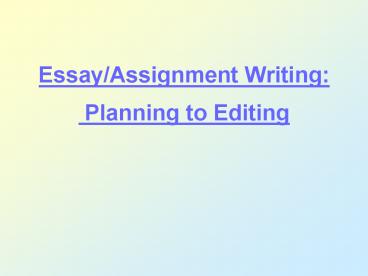Essay/Assignment Writing: Planning to Editing - PowerPoint PPT Presentation
1 / 22
Title:
Essay/Assignment Writing: Planning to Editing
Description:
Title: Essay Writing Author: am37 Last modified by: Preinstalled User Created Date: 10/5/2001 1:14:35 PM Document presentation format: On-screen Show (4:3) – PowerPoint PPT presentation
Number of Views:147
Avg rating:3.0/5.0
Title: Essay/Assignment Writing: Planning to Editing
1
Essay/Assignment Writing Planning to Editing
2
Agenda
- 4 stages in essay writing
- Preparing
- Planning
- Drafting
- Editing
3
Questions for you
- What makes a good essay?
- If you were marking an essay, what would you look
for?
4
To essay
- The verb to essay means to put to the test, to
attempt something difficult. - Essays give you opportunities to come to terms
with new knowledge. - Writing an essay helps you to measure how much
you really understand.
5
Four Stages in Writing an Essay
- 1. Preparing
- 2. Planning
- 3. Drafting
- 4. Editing
- Post-essay writing
- 5. Learning from the experience
6
Stage 1Preparing
- What question do I need to address and what does
it mean? - What do I know about this already?
- What do I need to find out?
- Research
7
Analyse the question
- What is the subject?
- What are the key verb(s)?
- What are the key aspect(s)?
- Any other other significant words?
- Ask questions about the question
8
Understand Key Verbs
- analyse
- compare and contrast
- describe
- discuss
- evaluate
- examine
- explore
- outline
- summarise
9
Paragraphing (I)
- Paragraphs structure thoughts and help the reader
- Each paragraph should contain
- one clear idea
- support sentences
- Support sentences add to the topic sentence, e.g.
- explain ideas raised
- define terms more fully
- give supporting detail
10
Paragraphing (II)
- For every paragraph, ask
- Is there one main idea here?
- Is it stated clearly?
- Is it properly supported with evidence?
- Have I commented on the evidence?
- Does it link with the previous paragraph and
anticipate the next?
11
Beginning a new paragraph
- To mark off the introduction and the conclusion
- To signal a shift to a new idea
- To indicate an important shift in time or place
- To emphasise a point
- To highlight a contrast
12
Stage 3Drafting
- Drafting shapes the notes into an essay.
- How?
- Revise, reconsider and rewrite what you have
done. - Fill in any gaps.
- Revise plan, now you know more.
13
Checking a Rough Draft
- Look for
- the sequence of ideas
- logic
- paragraphing
- sign-posting
- need more information?
- grammar
- punctuation
- Am I answering the question?
14
Introductions
- State clearly
- How you are going to answer the question
- What you are going to cover
- Address the question, the key idea.
- Define key terms.
- May help to write the introduction last.
- Should be 10 of the word count
15
Conclusions
- Pull the essay together.
- Show where you stand in the debate (judgement).
- Draw conclusions or extract general principles
(factual). - May indicate an area for further study.
- Link back to the question / essay title.
- 10-13 of the word count
16
Stage 4Editing
- Proof read your essay.
- Check for mistakes
- spelling
- grammar
- punctuation
- Check quotations, citations.
- Have I answered the question?
- Is there a logical, coherent argument?
17
Presentation
- Word limit
- Margins
- Spacing
- Font types and sizes
- Legibility
- Does it comply with the required layout?
- Diagrams
- References
18
Citations
- Examples
- According to Jones (1998), .
- Jones (1998) argued that .
- To quote from Jones (1998), .
- In name of text, Jones (1998) supported the idea
of . - . paraphrases . (Jones, 1998, p82)
19
Quotations
- Short quotation
- Jones (1999, p23) described the idea as quoting
a few words . - Long quotation
- Jones wrote long quotes
- long quotes
- long quotes (Smith, 1999, p9)
- etc. etc.
20
References
- Put at the end of an essay.
- Do not number them.
- Begin each source on a new line.
- List alphabetically by the first authors
surname. - Italicise the book or journal title.
- Place single quotation marks around the title of
an article within a journal.
21
Examples of References
- A book
- Cottrell, S.M. (1999) The Study Skills Handbook,
Macmillan. - An article in a book
- Tizard, B. (1991) Working Mothers and the Care
of Young Children in Woodhead, M., Light, P. and
Carr, R. (eds) Growing Up in a Changing Society,
Routledge.
22
Bibliography
- A list of everything you read for the assignment.
- They need not be referred to in your writing.
- Listed in the same style as references.































